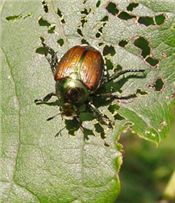Scout Fields Now For Japanese Beetles

Japanese beetles enjoy dining on more than 400 different plant species.
Photo credit: Chuck Bargeron, University of Georgia, Bugwood.org
COLUMBIA, MO.
Farmers and homeowners should be on the lookout for Japanese beetles, say University of Missouri Extension specialists. Beetles have been found in most parts of the state.
Numbers are expected to peak in mid-July.
MU Extension horticulture and agronomy specialist Todd Lorenz tells farmers to scout their fields now. He monitors beetles in Cooper, Boone, Pettis and Howard counties and has seen numbers increase steadily in June.
MU entomologist Ben Puttler says this year’s population appeared two weeks earlier than normal. “Two more full weeks of emerging beetles will play havoc,” Puttler says. In mid-Missouri, beetles skeletonize tops of ornamental trees such as Linden trees.
Japanese beetles also damage fruit trees and field crops. They feed on green corn silks and tassels, soybean leaves, and alfalfa forage.
Beetles are in the colonization stage in Missouri. At present, most rural areas of Missouri will see increasing populations as the pest disperses and establishes itself throughout the state, Puttler says.
“There are no known natural enemies to reduce beetle populations in the state and none are on the immediate horizon,” he says.
Adult Japanese beetles are metallic green in color with bronze- or copper-colored wing covers. They are about one-half inch long and have 12 white tufts of hair or bristles around the edge of the shell. Without magnification, these are seen as white dots. The adults usually emerge from the soil in late May or early June and reach peak numbers in June and early July. Numbers decrease in August.
Host plants develop a lacelike texture on leaves. The beetles damage corn tassels and developing silks, reducing yield.
Lorenz suggests applying an insecticide treatment to field corn during the silking period if there are three or more beetles per ear tip. Pollination should be less than 50 percent. In soybean, treatment is justified if foliage feeding exceeds 20-30 percent before bloom and 10-20 percent from bloom through pod fill. Use lower threshold numbers if plants are drought-stressed.
For more information from MU Extension on Japanese beetles, go to http://ipm.missouri.edu/pestMonitoring/jb . ∆